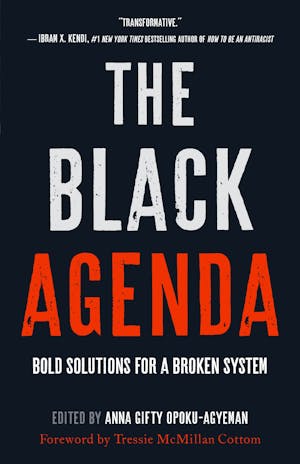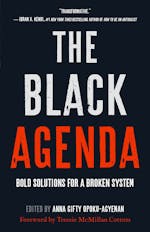THE WEATHER-CLIMATE GAP AND THE BLACK COMMUNITY
Marshall Shepherd
Climate change undoubtedly represents one of the most formidable challenges of our time. Yet some of the most vulnerable populations would likely challenge me on that statement. When faced with “kitchen table” issues like health care, monthly grocery bills, or heating the home, many people from marginalized communities are tempted to view climate change as a theoretical, academic construct about a starving polar bear, or only relevant to the distant future. In reality, the climate crisis is very much about those same familiar issues that Black America grapples with daily.
Studies continue to show that African American communities are disproportionately affected by climate-related hazards, such as heat, drought, hurricanes, and flooding, while accounting for a relatively small percentage of total carbon emissions. This so-called weather-climate gap is rooted in well-understood disparities associated with income, opportunity, and discriminatory practices. This gap presents a unique danger to Black Americans, making a sharper climate focus essential to the Black community’s well-being.
As an atmospheric scientist, it has been clear to me for decades that climate change is creating multifaceted risks for society. Our scientific trend lines, models, and analyses have long pointed to a “new normal” featuring intense hurricanes, prolonged heat waves, urban flooding, and debilitating drought. Cornell scholar Dr. Maria Cristina Garcia argues that people have been displaced by climate for thousands of years but that coping with the current crisis will require political will and adaptability of unprecedented scales. In 2005, the aftermath of Hurricane Katrina gave us a glimpse of what the weather-climate gap looks like for certain communities. To deconstruct that glimpse, it is important to explore the concept of vulnerability.
At its core, environmental vulnerability can be framed in terms of exposure and sensitivity. In the case of Katrina, for example, people throughout the Louisiana, Mississippi, and Alabama coastal region were “exposed” to the storm. However, there were also varying degrees of “sensitivity” (injury, harm, economic hardship, or death) to the floods, wind, power outages, and damaged homes among residents of this area. The convergence of these terms represents a measure of weather-climate vulnerability. While the entire region struggled, the faces etched in our minds of those needing shelter, food, and medical care at the Superdome were people of color and the poorest residents of New Orleans. Similar disparities in vulnerability have played out with Hurricane Harvey (2017) and the Chicago Heat Wave (1995). Even in the Caribbean region, people of color were disproportionately displaced by Hurricane Maria (2018).
Climate vulnerability as a function of race is structurally rooted in “place.” According to the U.S. Environmental Protection Agency (EPA), Black Americans are more likely to live in urban heat islands, portions of a city that tend to be significantly warmer than surrounding areas due to the abundance of man-made surfaces like asphalt, as well as a lack of vegetation, poor ventilation, and anthropogenic waste heat, or heat generated by human beings. In 2020, a study published in the Journal of the American Planning Association revealed that historical redlining practices might also account for some of these disparities. Redlining early in the twentieth century, the practice of outlining poor and minority neighborhoods with a red outline for bankers, lenders, and insurers, led to underlying climate injustices. The environmental justice movement grew out of recognition that industry viewed Black communities as dumping grounds for waste and locations for undesirable industries.
The “climate justice” movement must address the weather-climate gap. As Professor Robert Bullard, the Father of Environmental Justice, has articulated with fervor, zip code or “living on the wrong side of the tracks” should not determine one’s risk or vulnerability to an extreme weather event. Yet the evidence clearly establishes that it does. A study emerging from my research group at the University of Georgia by Neil Debbage, now at the University of Texas–San Antonio, found that African Americans in the Atlanta-to-Charlotte urban corridor were more likely to live in flood-prone areas.
The inequities of climate change are further amplified by the fact that the largest percentage of Black people resides in Southern states or cities. These regions experience the full suite of climatic hazards, including heat, hurricanes, tornadoes, drought, flooding, snowstorms, and wildfires. Communities will continue to struggle as such events increase in intensity or frequency. As a whole, African Americans lag behind in income, have higher health disparities, and have inadequate insurance. Heat waves, landfalling hurricanes, and flooding further amplify an already unequal burden. So what do we do?
African American communities must become more “climate-centric.” It is important to view climate change as an economic, health, and societal threat in the same way that we view COVID-19 or a recession. Communities must take ownership of climate planning and adaptation strategies that address the social disparities outlined. Disaster management planning and mitigation strategies must be developed and implemented in anticipation of future threats rather than as a reaction to an episodic event. From a political perspective, African Americans must vote with the climate crisis in mind on the local, state, and national levels. Ultimately, however, the weather-climate gap will not disappear until racial wealth inequality disappears.
The “new energy” economy of solar, wind, and other sources creates an unprecedented opportunity for mitigating this inequality. The African American community must be positioned to benefit from and leverage this new economic reality. Put another way, we must be trained in blue-collar and STEM-based jobs, prepare our communities for new infrastructure, and envision new economic realities in a non-fossil-fuels-based economy. It remains to be seen whether a “Green New Deal” will garner enough bipartisan support to flourish, but there will likely be some action along such lines in the future. Are we ready?
Dr. Martin Luther King’s Letter from Birmingham Jail was written with a charge for community action and a stance against racial injustice. However, his poignant remarks are relevant herein.
I am cognizant of the interrelatedness of all communities and states. I cannot sit idly by in Atlanta and not be concerned about Birmingham. Injustice anywhere is a threat to justice everywhere. We are caught in an inescapable network of mutuality, tied in a single garment of destiny. Whatever affects one directly, affects all indirectly.
Before joining the faculty at the University of Georgia, I spent twelve years of my career as a scientist at NASA’s Goddard Space Flight Center. We studied Earth as a system because the atmosphere, oceans, cryosphere, and biosphere are all interconnected. Just as Dr. King saw a network of mutuality in the Civil Rights Movement, I see it in our shared vulnerability and response to climate change. The weather-climate gap is fundamentally an issue of civil rights, and we must approach it as such to create a safe and equitable world for all.
Works Cited
Debbage, Neil. “Multiscalar Spatial Analysis of Urban Flood Risk and Environmental Justice in the Charlanta Megaregion, USA.” Anthropocene 28 (2019): 100226. https://www.sciencedirect.com/science/article/abs/pii/S2213305419300372.
EPA. “Heat Islands and Equity.” http://epa.gov/heatislands/heat-islands-and-equity.
Wilson, Bev. “Urban Heat Management and the Legacy of Redlining.” Journal of the American Planning Association 86, no. 4 (2020): 443–457. doi: 10.1080/01944363.2020.1759127. https://www.tandfonline.com/doi/full/10.1080/01944363.2020.1759127.
Copyright © 2022 by Anna Gifty Opoku-Agyeman






